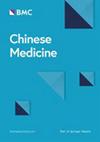NBR1-p62-Nrf2 mediates the anti-pulmonary fibrosis effects of protodioscin
IF 5.3
3区 医学
Q1 INTEGRATIVE & COMPLEMENTARY MEDICINE
引用次数: 0
Abstract
Idiopathic pulmonary fibrosis is a persistent disease of the lung interstitium for which there is no efficacious pharmacological therapy. Protodioscin, a steroidal saponin, possesses diverse pharmacological properties; however, its function in pulmonary fibrosis is yet to be established. Hence, in this investigation, it was attempted to figure out the anti-pulmonary fibrosis influences of protodioscin and its pharmacological properties related to oxidative stress. A mouse lung fibrosis model was generated using tracheal injections of bleomycin, followed by intraperitoneal injection of different concentrations of protodioscin, and the levels of oxidative stress and fibrosis were detected in the lungs. Multiple fibroblasts were treated with TGF-β to induce their transition to myofibroblasts. It was attempted to quantify myofibroblast markers’ expression levels and reactive oxygen species levels as well as Nrf2 activation after co-incubation of TGF-β with fibroblasts and different concentrations of protodioscin. The influence of protodioscin on the expression and phosphorylation of p62, which is associated with Nrf2 activation, were detected, and p62 related genes were predicted by STRING database. The effects of Nrf2 inhibitor or silencing of the Nrf2, p62 and NBR1 genes, respectively, on the activation of Nrf2 by protodioscin were examined. The associations between p62, NBR1, and Keap1 in the activation of Nrf2 by protodioscin was demonstrated using a co-IP assay. Nrf2 inhibitor were used when protodioscin was treated in mice with pulmonary fibrosis and lung tissue fibrosis and oxidative stress levels were detected. In vivo, protodioscin decreased the levels of fibrosis markers and oxidative stress markers and activated Nrf2 in mice with pulmonary fibrosis, and these effects were inhibited by Nrf2 inhibitor. In vitro, protodioscin decreased the levels of myofibroblast markers and oxidative stress markers during myofibroblast transition and promoted Nrf2 downstream gene expression, with reversal of these effects after Nrf2, p62 and NBR1 genes were silenced or Nrf2 inhibitors were used, respectively. Protodioscin promoted the binding of NBR1 to p62 and Keap1, thereby reducing Keap1-Nrf2 binding. The NBR1-p62-Nrf2 axis is targeted by protodioscin to reduce oxidative stress and inhibit pulmonary fibrosis.NBR1-p62-Nrf2介导原薯蓣皂甙的抗肺纤维化作用
特发性肺纤维化是肺间质的一种顽疾,目前尚无有效的药物疗法。原薯蓣皂甙是一种甾体皂甙,具有多种药理特性,但其在肺纤维化中的作用尚待确定。因此,本研究试图找出原薯蓣皂苷抗肺纤维化的影响及其与氧化应激相关的药理特性。通过气管注射博莱霉素,然后腹腔注射不同浓度的原薯蓣皂苷,建立了小鼠肺纤维化模型,并检测了肺部氧化应激和纤维化的水平。用 TGF-β 处理多种成纤维细胞,诱导其向肌成纤维细胞转化。在 TGF-β 与成纤维细胞和不同浓度的原薯蓣皂苷共同作用后,尝试量化肌成纤维细胞标记物的表达水平和活性氧水平以及 Nrf2 的激活情况。检测了原薯蓣皂苷对与Nrf2活化相关的p62表达和磷酸化的影响,并通过STRING数据库预测了p62相关基因。分别检测了Nrf2抑制剂或沉默Nrf2、p62和NBR1基因对原薯蓣皂苷激活Nrf2的影响。使用共同 IP 检测法证明了 p62、NBR1 和 Keap1 在原薯蓣皂苷激活 Nrf2 过程中的关联。在原薯蓣皂苷治疗肺纤维化小鼠时使用了 Nrf2 抑制剂,并检测了肺组织纤维化和氧化应激水平。在体内,原薯蓣皂苷降低了肺纤维化小鼠肺纤维化标志物和氧化应激标志物的水平,并激活了 Nrf2,Nrf2 抑制剂抑制了这些效应。在体外,原薯蓣皂苷降低了肌成纤维细胞转化过程中肌成纤维细胞标志物和氧化应激标志物的水平,并促进了Nrf2下游基因的表达,在分别沉默Nrf2、p62和NBR1基因或使用Nrf2抑制剂后,这些效应被逆转。原薯蓣皂苷促进了 NBR1 与 p62 和 Keap1 的结合,从而减少了 Keap1-Nrf2 的结合。原薯蓣皂苷以NBR1-p62-Nrf2轴为靶标,减少氧化应激,抑制肺纤维化。
本文章由计算机程序翻译,如有差异,请以英文原文为准。
求助全文
约1分钟内获得全文
求助全文
来源期刊

Chinese Medicine
INTEGRATIVE & COMPLEMENTARY MEDICINE-PHARMACOLOGY & PHARMACY
CiteScore
7.90
自引率
4.10%
发文量
133
审稿时长
31 weeks
期刊介绍:
Chinese Medicine is an open access, online journal publishing evidence-based, scientifically justified, and ethical research into all aspects of Chinese medicine.
Areas of interest include recent advances in herbal medicine, clinical nutrition, clinical diagnosis, acupuncture, pharmaceutics, biomedical sciences, epidemiology, education, informatics, sociology, and psychology that are relevant and significant to Chinese medicine. Examples of research approaches include biomedical experimentation, high-throughput technology, clinical trials, systematic reviews, meta-analysis, sampled surveys, simulation, data curation, statistics, omics, translational medicine, and integrative methodologies.
Chinese Medicine is a credible channel to communicate unbiased scientific data, information, and knowledge in Chinese medicine among researchers, clinicians, academics, and students in Chinese medicine and other scientific disciplines of medicine.
 求助内容:
求助内容: 应助结果提醒方式:
应助结果提醒方式:


